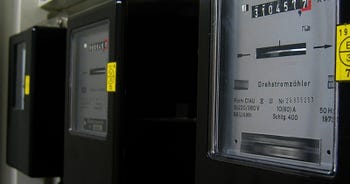Is natural gas renewable?
As a growing number of businesses make a conscious effort to become more environmentally friendly, the demand for renewable energy grows.
Renewable electricity comes from a number of natural sources, including wind, solar, and wave power. But when it comes to gas, is natural the same as renewable natural gas?
What is natural gas?
Natural gas is a fossil fuel that’s formed naturally underground from the decomposing remains of animals, plants, and organic matter that died millions of years ago. Diving briefly into the science, natural gas is mainly made up of methane, nitrogen, carbon dioxide, and other hydrocarbons.
Although natural, gas resources are finite, which means it’s not renewable. And it’s not very environmentally friendly either. Because natural gas lies even deeper below the Earth’s surface than oil, this makes it difficult to harness and the processes used to extract natural gas can be damaging to the environment.
Fracking, for instance, uses high power jets of fluid to drill down into deep-lying rocks and release the gas inside. This method is believed to cause earth tremors and has been banned in the UK and across much of Europe.
But there is another type of natural gas available that doesn’t come with the same risks attached. When organic waste - such as animal waste or rotting food - decomposes, it releases biogas into the atmosphere. When this gas is captured and purified, it creates renewable natural gas – or RNG for short.
What is RNG?
RNG - renewable natural gas – is made from decomposing organic matter, much like non-renewable natural gas. But RNG is created using environmentally sustainable waste sources that are constantly being replenished, such as animal waste, crop residuals and food waste.
If you want more of the science behind RNG production, it’s created by cleaning and conditioning biomethane (which is a mix of carbon dioxide and methane). When producing RNG, any non-methane elements are removed or reduced to produce renewable natural gas.
RNG is considered to be an upgraded alternative to fossil natural gas as it comes from renewable sources and is made using more environmentally friendly extraction methods.
Where does RNG come from?
RNG can be produced from a range of sources by using a biochemical process to break down the raw materials into gas that can be used for power.
Anaerobic digestion is the most common process. It involves bacteria breaking down (or digesting) organic matter - such as animal manure, wastewater biosolids, and food wastes - without the presence of oxygen (that’s the anaerobic part of the process).
This gas is then purified to make RNG. Here’s how it works:
- Anaerobic digestion - Organic waste is put into an oxygen-free, temperature-controlled tank (known as a digester tank). This waste is then broken down (digested) by naturally occurring bacteria. Raw biogas – a mixture of methane, carbon dioxide and some other gases - is created as a byproduct of this digestion process.
- Purification - Once the biomethane has been captured, it’s stripped of all other gases except methane and carbon dioxide. The carbon dioxide is then removed to create a gas made up almost entirely of methane, with a small amount of nitrogen. This biomethane – or RNG – is almost impossible to distinguish from conventional natural gas and can be used in the same way.
But where do the raw materials come from to create RNG? There are four main sources:
1. Landfill
Landfill sites are one of the biggest sources of RNG production, as the gas can be extracted from waste created by residential, industrial, and commercial use. As landfills are considered the third-largest source of human-related emissions in the US according to the U.S. Environmental Protection Agency(PDF), it has now become one of the most popular ways to create RNG worldwide. Biogas from landfill is also sometimes referred to as landfill gas (LFG) and the process takes place in the ground rather than an anaerobic digester.
2. Livestock waste
Unwanted livestock waste like manure is another way that RNG can be created. The waste from farmland is collected and delivered to an anaerobic digester to stabilize methane production. It is then converted into RNG and distributed to industries that need it.
3. Wastewater treatment
RNG can also be created by separating solids from wastewater, this is another popular method and can be very efficient. Sewage water is filtered to remove any contaminants and can then be converted to RNG or alternatively returned to the water cycle to reuse.
4. Food waste
Another effective source of RNG is the collection of waste from food manufacturing wholesalers such as supermarkets, restaurants, hospitals, and schools. Biogas can also be created from sources including crop residues, wood biomass, and energy crops – or lignocellulosic materials, as they’re known in more scientific circles.
So far, so good. But there are some downsides to RNG, mainly that it’s a potent greenhouse gas. And potent greenhouse gasses play a big part in climate change. So, is renewable natural gas production worth the risk?
What is the environmental impact of RNG compared with other fuels?
Let’s start with the negatives – any methane that is released into the atmosphere will contribute to climate change. Although biomethane is created in sealed, oxygen-free tanks, leaks will happen when the gas is being extracted, transported and used.
But is it really that bad for the environment? In a word, yes. We all know that the release of carbon dioxide into the atmosphere is bad for the environment – that's why we need to plant more trees and look after our oceans to help absorb it and reduce climate change. Well, natural gas is more than three times stronger than carbon dioxide at trapping heat.
It's not all bad news though. One big plus point for RNG is that burning it for fuel doesn’t contribute to climate change. Although burning biomethane does produce certain particles that help to create smog, it does so on a much smaller scale than gasoline and diesel.
When you weigh up the pros and cons of using RNG, although it’s far from perfect, it is a more environmentally friendly option than other fossil fuels. The real problem is that it could be too little, too late - the Intergovernmental Panel on Climate Change (IPCC) suggests we need to decarbonize by 2030 to mitigate the worst effects of climate change. And simply making the switch to RNG won’t be enough to achieve this.
Can I switch my business gas supply to RNG?
If you want to switch to renewable natural gas for business, it’s worth knowing that the availability of RNG – also known as green gas – is still pretty limited in the UK.
Unlike renewable business electricity, which is widely available from a number of sources and suppliers, there are only a handful offering renewable gas. Even if you ring around every business energy supplier in the book, there’s no guarantee that green gas will be available in your part of the country.
That’s why it makes sense to speak to Bionic’s tech-enabled experts instead. One quick call is all it takes to find out if you can make the switch to RNG. If not, we’ll still be able to find you a better deal on business gas that could save you money. When your contract is up for renewal again, we’ll be able to let you know if the situation has changed and whether you can switch to green gas.
Although the technology isn’t 100% environmentally friendly and may not yet be widely available, switching to RNG is a step in the right direction as it’s much kinder to the environment than other options.
And if doing your bit for the environment is your main motivation for making the switch, it’s also worth speaking to us about a green business electricity deal. The range of renewable electricity deals now available means switching could help you cut your business energy bills while doing your bit for the planet.








